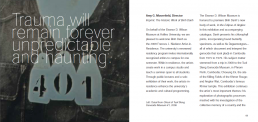Imprint: The Historic Work of Binh Danh exhibition catalogue essay
Catalogue introduction in “Binh Danh: In the Eclipse of Angkor,” 2009. Perfect bound book. Full color printing. 2010 Addy Gold Award, SEMC Award (2010).
On behalf of the Eleanor D. Wilson Museum at Hollins University, we are pleased to welcome Binh Danh as the 2009 Frances J. Niederer Artist-in-Residence. The university’s renowned residency program invites internationally recognized artists to campus for one semester. While in residence, the artists create work in a campus studio and teach a seminar open to all students. Through public lectures and a solo exhibition of their work, the artists-in-residence enhance the university’s academic and cultural programming.
The Eleanor D. Wilson Museum is honored to premiere Binh Danh’s new body of work, “In the Eclipse of Angkor.” In this exhibition and accompanying catalogue, Danh presents his chlorophyll prints, incorporating found butterfly
specimens, as well as his Daguerreotypes—all of which document and interpret the genocide that took place in Cambodia from 1975 to 1979. His subject matter stemmed from a trip in 2008 to the Tuol Sleng Genocide Museum, in Phnom
Penh, Cambodia; Choeung Ek, the site of the Killing Fields of the Khmer Rouge; and Angkor Wat, Cambodia’s famous Khmer temple. This exhibition continues the artist’s most important themes: his exploration of photographic processes meshed with his investigation of the collective memory of a country and the principles of redemption and justice. “Photography has allowed me to meditate on death and its influence on the living,” he says. “The themes of mortality, memory, history, landscape, justice, evidence, and spirituality encompass this [work].” 1
Born in Vietnam in 1977, two years after the fall of Saigon, Danh and his family left their home in 1979 and immigrated to the United States in the early 1980s. The experience of displacement and his eventual trip back to his country of birth inspired the artist to create work exploring his homeland’s history using found and natural materials. By inventing a process known as chlorophyll printing,2 Danh found the perfect metaphor to honor the thousands of people murdered by the Khmer Rouge regime. Printed on the leaves of a variety of tropical plants such as nasturtiums and elephant ears, Danh’s portraits of the victims are permanently imprinted into the matrix of the leaves’ structure. Danh states, “I am using these tools of science to help me articulate these complex concepts…science for me is truth and knowledge and history is about preservation.” 3 In gazing at the subversively beautiful portraits of nameless victims, such as those in “Transitional Justice,” 2008, the viewer acts as a witness in the larger historical context of the work.
This exhibition pairs Danh’s chlorophyll prints with daguerreotypes that present a contemporary geographical context for the victims’ portraits, as depicted in the works “Memories of Tuol Sleng Genocide Museum #1” and “A view from the center of a mass grave, Choeung Ek.” Danh creates a delicate push/pull between the two bodies of work, providing both a microscopic and macroscopic view of the atrocities committed on a population. The work is quietly interactive. The viewer completes Danh’s intent by bearing witness to the tragedy of genocide, thereby being forever changed by what is seen.
1 Binh Danh’s Artist Statement, November 2008.
2 Danh’s technique of chlorophyll printing is described in Johanna Ruth Epstein’s, Ph.D. catalogue essay “Binh Danh: From Memory to Memory.” December 2008.
3 Artist’s interview with Boreth Ly “The Leaves of g(race)” 2006.


